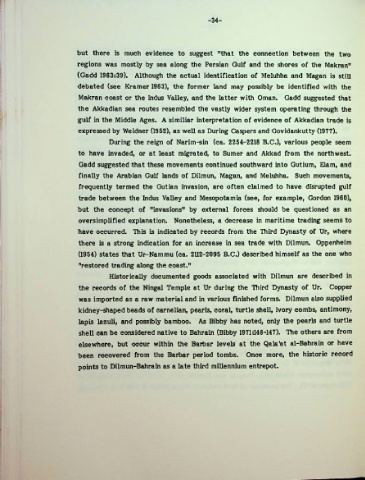Page 58 - Life & Land Use on the Bahrain Islands (Curtis E Larsen)
P. 58
-34-
but there is much evidence to suggest "that the connection between the two
regions was mostly by sea along the Persian Gulf and the shores of the Makran"
(Gadd 1963:39). Although the actual identification of Meluhha and Magan is still
debated (see Kramer 1963), the former land may possibly be identified with the
Makran coast or the Indus Valley, and the latter with Oman. Gadd suggested that
the Akkadian sea routes resembled the vastly wider system operating through the
gulf in the Middle Ages. A similiar interpretation of evidence of Akkadian trade is
expressed by Weidner (1952), as well as During Caspers and Govidankutty (1977).
During the reign of Narim-sin (ca. 2254-2218 B.C.), various people seem
to have invaded, or at least migrated, to Sumer and Akkad from the northwest.
Gadd suggested that these movements continued southward into Gutium, Elam, and
finally the Arabian Gulf lands of Dilmun, Magan, and Meluhha. Such movements,
frequently termed the Gutian invasion, are often claimed to have disrupted gulf
trade between the Indus Valley and Mesopotamia (see, for example, Gordon 1960),
but the concept of "invasions" by external forces should be questioned as an
oversimplified explanation. Nonetheless, a decrease in maritime trading seems to
have occurred. This is indicated by records from the Third Dynasty of Ur, where
there is a strong indication for an increase in sea trade with Dilmun. Oppenheim
(1954) states that Ur-Nammu (ca. 2112-2095 B.C.) described himself as the one who
"restored trading along the coast."
Historically documented goods associated with Dilmun are described in
the records of the Ningal Temple at Ur during the Third Dynasty of Ur. Copper
was imported as a raw material and in various finished forms. Dilmun also supplied
kidney-shaped beads of carnelian, pearls, coral, turtle shell, ivory combs, antimony,
lapis lazuli, and possibly bamboo. As Bibby has noted, only the pearls and turtle
shell can be considered native to Bahrain (Bibby 1971:146-147). The others are from
elsewhere, but occur within the Barbar levels at the Qala’at al-Bahrain or have
been recovered from the Barbar period tombs. Once more, the historic record
points to Dilmun-Bahrain as a late third millennium entrepot.

